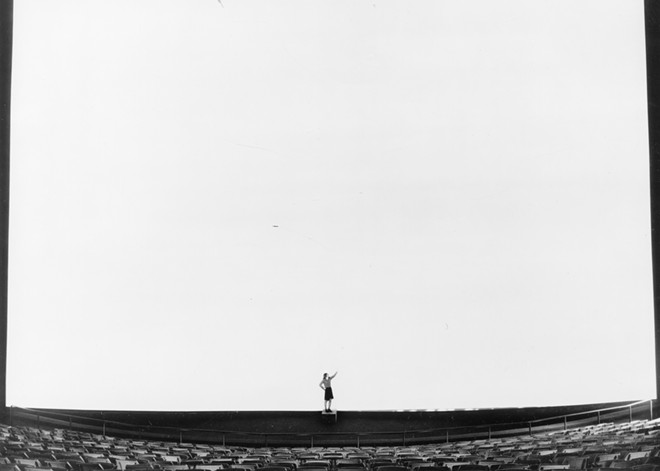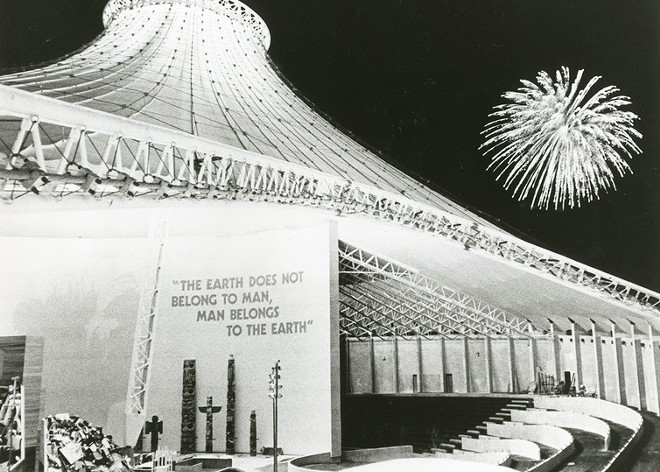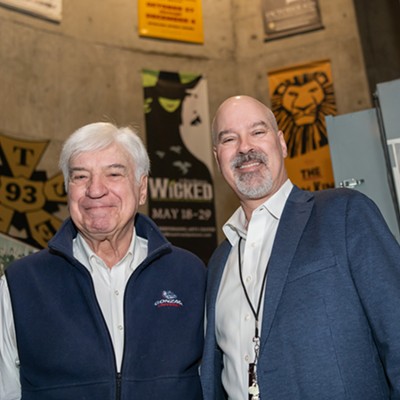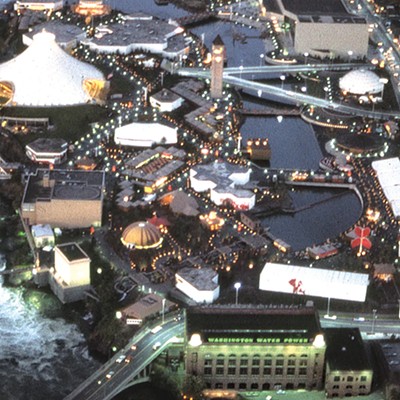
When we gaze at the skeletal Spokane Pavilion these days, we see instantly recognizable local iconography — a city landmark set amid a thriving downtown park that's truly Expo '74's gift that keeps on giving.
When those attending Expo '74 first saw the towering, covered tent that housed the U.S. Pavilion, most probably had a completely different thought: I'm about to see the biggest movie screen in the world!
See, the U.S. Pavilion's main attraction — which many cited as the draw of the fair — was a completely novel technological innovation at the time: an IMAX theater.
While Spokane didn't host IMAX's debut, it was certainly the massive movie technology's introduction to many Americans and worldly attendees. IMAX actually debuted at Expo '70 in Japan, but the 70mm large-screen format was still a rarity. The only other permanent IMAX screens on the planet at the time Spokane hosted its world's fair were located at Ontario Place in Toronto, the Reuben H. Fleet Science Center in San Diego and the Circus World theme park in Florida.
But the IMAX screen at Expo '74? It dwarfed them all.
At the time it was the biggest movie screen in the world — a towering six-story behemoth that was 65 feet tall and 90 feet wide. For comparison, the IMAX screen at the AMC River Park Square 20 is a mere 27 feet high and 53 feet wide.
The screen was BIG.

Keeping with Expo '74's environmental theme, the film that played on the ginormous screen was Man Belongs to the Earth, a 22-minute experiential nature documentary by Canadian filmmaker and IMAX co-founder Graeme Ferguson. The film combines immersive, sweeping shots of American wonders like the Grand Canyon and whitewater river rafting with critical scenes of the negative impact humankind has had on the land, paired with stirring narration by Oscar-nominated actor Chief Dan George of the Tsleil-Waututh Nation. (If you're interested in a taste of the film on a much smaller screen, a low-def transfer of Man Belongs to Earth can be viewed for free on PublicResourceOrg's YouTube page.)
For those who've grown up with IMAX as a given in the pop culture space, it's hard to emphasize how brain-breaking the immersion of Man Belongs to the Earth was for those Expo patrons — especially the opening sequence. After zooming in on an image of the Earth floating in space, viewers were suddenly soaring above the Grand Canyon via footage shot by a camera attached to the front of a twin-engine Piper Aztec plane.
"When you see that stuff for the first time... my God, you thought you were falling!" recalls Jim Oliver, who worked at the fair as the assistant to the commissioner of the U.S. Pavilion. "It did not matter where you sat in the theater — you got the feeling that you were flying. Part of the introductory thing was [a warning] if you've got heart issues [or] if you throw up easy."
In the book Spokane's Expo '74: Images of Modern America, world's fair expert Bill Cotter writes: "The film amazed audiences with its size and clarity... that is so realistic some guests needed airsickness bags."
Cotter also notes that it wasn't only the viewers who felt queasy, as the film was a bit of an anomaly for a host country's centerpiece, in that its environmental message was quite self-critical, writing, "Two major problems it explores are smog and strip-mining; a scene of heavy smog inundating Denver, Colorado, prompted complaints from civic leaders and an apology from the Expo staff."
The New York Times' John van der Zee was very critical of what he saw as Expo '74's largely hollow and performative environmental messaging, but did credit Man Belongs to the Earth with being blunt about the situation, writing, "The film... is honest enough to include interviews with at least one genuinely angry American, a disgruntled lettuce grower seen plowing under his smog-ruined crop; also, with a young farmer who is skeptical of any meaningful action being taken in behalf of the American environment, ever."
It's a message that stuck with those who saw the film — which was thousands upon thousands of people. Multiple screenings occurred every hour throughout the entire duration of the fair in the 850-seat theater.
The power of Chief Dan George's narration comes up often when talking to those who saw the film at Expo. There was no formal script for the movie, rather an Indigenous staffer spent days with George recording their discussions about the environment and picked out powerful ideas that the actor could recount as the cameras were rolling.
It's hard not to be moved by his final monologue in the film: "Thank you, Sun. Thank you for your light. Come again tomorrow. Have mercy on us human beings."
While the centerpiece Expo '74 screen was torn down after the fair, IMAX's legacy continued in Spokane. A dedicated IMAX theater was built not far from the original in Riverfront Park, opening in 1978 and operating until its demolition in 2018. Now only the smaller IMAX screen at River Park Square remains.
Fifty years since its Expo showcase, IMAX is reaching new heights befitting its giant film and screens. It helps that one of cinema's greatest directors, Christopher Nolan, happens to be an IMAX fanboy. Earlier this year, Oppenheimer became the first movie shot on IMAX to win the Academy Award for Best Picture. IMAX's Chief Quality Guru David Keighley, who's been working for IMAX since 1972, emphasizes how crucial Expo '74's IMAX presentation was to the company's future.
"I think it was everything. I think if those world's fairs hadn't been happening, I don't know whether IMAX really would have been able to flourish. It was only because people saw them at the expos. It was instrumental," says Keighley, adding, "The cameras that shot Man Belongs to Earth — the same format and pretty well the same cameras — are used today by Christopher Nolan."
And while IMAX's enduring legacy continues to be a boon for moviegoers, the impact for those who attended and worked at Expo '74 hints at something more emotionally resonant. As Oliver points out, America was in turmoil at the time, between the Vietnam War and President Nixon's Watergate scandal (even just three months from his resignation, the POTUS headlined Expo '74's opening day ceremonies). Getting to show off a wonder like Man Belongs to the Earth on the world's biggest screen strangely provided a sense of hope for a brighter future.
"People were a little disconcerted about life in America. But the Expo was America's best foot forward," Oliver says. "You had these spectacular things like the IMAX. And you just felt, 'My God, a lot of people have put in a lot of work, and now I'm here to represent our country to the world.' It probably sounds corny, but at the time, that's how we all felt. It was an extreme honor to be at the U.S. Pavilion. It wasn't a summer job. It was making memories." ♦


























